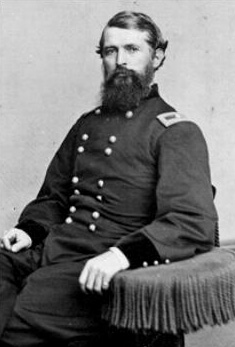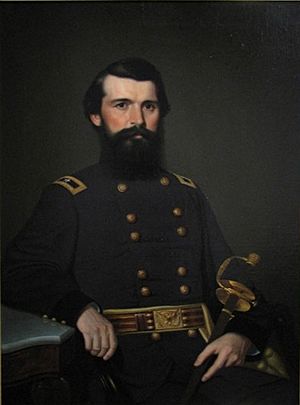Samuel P. Carter facts for kids
Quick facts for kids
Samuel Perry "Powhatan" Carter
|
|
|---|---|

Samuel P. Carter
|
|
| Born | August 6, 1819 Elizabethton, Tennessee |
| Died | May 26, 1891 (aged 71) Washington, D.C. |
| Place of burial |
Oak Hill Cemetery, Georgetown, Washington, D.C.
|
| Allegiance | United States of America Union |
| Service/ |
United States Navy United States Army |
| Years of service | 1840–1861, 1865–1881 (USN) 1861–1865 (USA) |
| Rank | |
| Battles/wars | Mexican–American War American Civil War |
| Other work | Asst. Professor of Mathematics, United States Naval Academy |
Samuel Perry Carter (born August 6, 1819 – died May 26, 1891) was a unique officer in the United States military. He was known by the nickname "Powhatan." During the American Civil War, he served in the Union Army as a brevet major general. After the war, he became a rear admiral in the United States Navy.
What makes Samuel Carter so special is that he is the only U.S. officer ever to be both a general in the Army and a "flag officer" (a high-ranking admiral) in the Navy. This shows how talented and versatile he was!
Template:TOC limit=3
Contents
Samuel Carter was born in Elizabethton, Tennessee. His family had deep roots in the area, with Carter County even named after his ancestors. He had two younger brothers, William Blount Carter and James Patton Taylor Carter.
Samuel went to several schools, including Duffield Academy and Princeton University. In February 1840, he joined the U.S. Navy as a midshipman. This was a training role for future officers. He spent five years serving in places like the Pacific and the Great Lakes.
After his early service, he went to the United States Naval Academy. He graduated in 1846. Soon after, he fought in the Mexican–American War aboard the USS Ohio. He was part of the Battle of Veracruz.
After the war, Carter worked at the United States Naval Observatory. He also taught math at the U.S. Naval Academy for three years, from 1850 to 1853. He continued to serve at sea and was promoted to lieutenant in April 1855. In 1856, he was on the USS San Jacinto when it attacked Chinese forts. He then returned to the Naval Academy until 1860.
Serving in the Civil War
When the American Civil War was about to begin in 1861, Samuel Carter wrote to Senator Andrew Johnson from Tennessee. Carter promised he would stay loyal to the Union. Senator Johnson helped Carter get permission to leave the Navy temporarily. Carter's mission was to organize Union supporters in his home area of East Tennessee. Most people there wanted to stay with the Union.
However, Confederate soldiers took control of the region, making it hard for Carter to organize. So, he gathered a group of East Tennesseans who had escaped to Kentucky. During this time, he used "Powhatan" as a secret code name when talking to Unionists still behind enemy lines. His younger brother, William B. Carter, even planned a secret mission to burn bridges in East Tennessee in late 1861.
Carter was made a brigadier general in the Army, even though he was still a Navy officer. He led soldiers at the Battle of Mill Springs in January 1862. He also helped capture Cumberland Gap in June 1862. Carter hoped to invade East Tennessee, but the Union forces had to retreat when Confederate General Braxton Bragg moved into Kentucky.
Carter's Daring Cavalry Raid
After Bragg's army was defeated, Carter convinced his leaders to let him lead a raid into East Tennessee. His goal was to damage the important East Tennessee and Virginia Railroad. This would help the Union army in Middle Tennessee. It would also test if the mountain route was good for a larger invasion.
This raid became the first long-distance, large-scale cavalry raid by the Union army during the war. Carter led almost 1,000 men through the tough mountains of Kentucky and Tennessee in late 1862. On December 30, he destroyed railroad and wagon bridges at Union and Carter's Depot (now Watauga). He defeated Confederate forces, captured a train, and destroyed a lot of military supplies. He returned safely to Kentucky on January 2, 1863.
Even though the raid was a success, Carter reported that the mountain route was too difficult for a large army. So, plans for a full invasion of East Tennessee were canceled.
In July 1863, Carter took command of the cavalry division of the XXIII Corps. He continued fighting across Tennessee, including during the Battle of Blue Springs in the Knoxville Campaign.
By 1865, Carter was in North Carolina. He commanded part of the Union forces at the Battle of Wyse Fork. On March 13, 1865, he was promoted to brevet major general. He briefly commanded the XXIII Corps before leaving the volunteer army in January 1866.
While he was serving in the Army, the U.S. Navy also promoted him. He became a lieutenant commander in 1863 and a commander in 1865.
Life After the War
After the Civil War, Carter went back to serving in the Navy. Because of his excellent war record, he was made a commander. He joined the Pacific Squadron and commanded the USS Monocacy.
He continued to rise in rank, becoming a captain in October 1870. He served as the leader of midshipmen at the Naval Academy until 1873. Then, he went back to sea duty in Europe. In 1877, he became a member of the Lighthouse Board, which oversaw lighthouses.
After the war, Carter also joined the Military Order of the Loyal Legion of the United States (MOLLUS). This was a group for Union officers and their families.
In 1877, Carter married Martha Custis Williams. She was a descendant of Martha Custis Washington. He was promoted to commodore in November 1878. Samuel Carter retired from the Navy in August 1881. Shortly after, in May 1882, he was promoted to rear admiral on the retired list. He lived in retirement until he passed away in Washington, D.C.. He is buried in Oak Hill Cemetery.
Other officers who knew Carter remembered him as "tall, handsome and dignified." They said he was "graceful in carriage and very affable." They also called him a "soldierly Christian" who was very religious and brave.
There is a special historical marker in his hometown of Elizabethton, Tennessee, that honors his life and Navy career.
Key Dates and Ranks
- Midshipman – February 14, 1840
- Passed Midshipman – July 11, 1846
- Master – September 12, 1854
- Lieutenant – April 18, 1855
- Brigadier General, Volunteer Army – May 1, 1862
- Lieutenant Commander – July 16, 1862
- Brevet Major General – Volunteer Army – March 13, 1865
- Commander – June 25, 1865
- Mustered out of Volunteer Army – January 15, 1866
- Captain – October 28, 1870
- Commodore – November 13, 1878
- Retired List – August 6, 1881
- Rear Admiral on Retired List – May 16, 1882




